ANSMET team • Jan 04, 2009
The Antarctic search for meteorites: not for the impatient
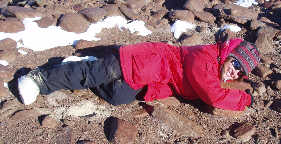
Amy gives some love to the Ferrar dolerite
...even though it is a tricky "meteorwrong!"ANSMET
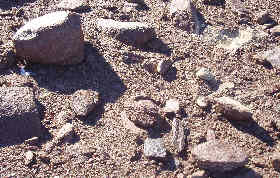
Mars-scape?
ANSMET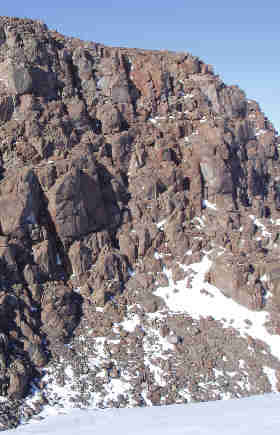
Cliffs of Ferrar dolerite
ANSMETDecember 30, 2008 - January 4, 2009
Mars in Antarctica?
December 30, 2008
Participating in ANSMET is an amazing experience on many levels. We’ve found over 100 meteorites so far, and the season is young! There’s nothing like finding space rocks that can tell you about the asteroids and other bodies in the solar system. But, seeing rocks and soils similar to those you have studied for years, in their native habitat, comes close!
Part of my doctoral work involved studying the Antarctic weathering of the Ferrar dolerite, a very common rock near our field site. (Dolerite is a type of rock that forms by crystallization of magma within the Earth's crust. Geologists name different rock formations for ease in communication, and the dolerite in Antarctica is called "Ferrar.") Although I have started to develop a love/hate relationship with the Ferrar because it is a good “meteorwrong” (a tongue-in-cheek expression for a rock that can be easy to mistake for a meteorite), it has the redeeming quality that it is similar in many ways to certain types of martian meteorites.
I have studied how water might have weathered this Mars-like rock in Antarctica, a Mars-like environment, to try to understand possible water-related processes on Mars. Although tons of invaluable information was provided by Ralph (along with the samples!) and although I’ve read lots of papers about the Ferrar dolerite in Antarctica, I had never seen it in person. So, when I saw the weathered rocks and soils on top of a nearby nunatak a few days ago, I just had to become a Ferrar-hugger.
The similarity of the landscape to a view of the martian surface (minus the snowy parts) struck me, as well. Even though I had studied these rocks and soils as Mars analogs, standing in the cold desert of Antarctica staring at the orange-brown landscape of broken up rocks really hit that home. Antarctica provides us with many ways to learn about other planets, from revealing pieces of them in the form of meteorites to providing materials that are analogs to materials on other planets!
100 years ago this date: Shackleton and his mates had a setback. A blizzard from the south sprang up in the morning, forcing them to camp. They made only 4 miles that day, putting them behind in their plan of march.
--Amy
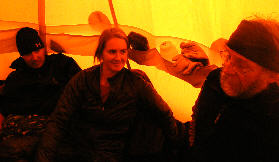
Deon, Jani and John squeezed on one side of the ladies tent.
ANSMETRinging out the old
December 31, 2008
This will be a short post. It's New Year's Eve.
Today started windy. When I woke up I could hear the wind flapping the tent sides and the hiss of snow blowing against the tent. I knew we would not start work early so I stayed in the sleeping bag. The wind died down just a little during the morning, so we decided to try foot-searching a moraine after lunch. Walking around, rather than searching from a ski-doo, would help keep us warm while we were outside. That is the theory. We kept at it for about an hour and a half, but then decided to return to camp in mid afternoon. This was not our most productive day; we found only one meteorite.
Being New Year's Eve, we had planned to have a communal supper, and the ladies agreed to host it in their tent. We started at 5:30 p.m. Supper transitioned into wide ranging discussions on the ANSMET program, mountaineering, prospecting for precious metals in South Africa, cooking disasters, life on Mars, and other topics too numerous to mention. (Or remember.) Six people in a tent designed to house two gets awfully cramped. Finally, after four hours, the elderly among us (including yours truly) had to get out, if for no other reason than to make sure we could still straighten our legs.
That was our New Year's Eve. I do not know about the others, but I made the same New Year's Resolution I make every year; I resolved to make it through the upcoming year. So far, I haven't failed in this.
100 years ago this date: Shackleton's team is still man-hauling uphill, fighting through troublesome soft snow, and into icy katabatic winds. Nevertheless, they make 11 miles on the day. However, they have only three weeks of food left, but 500 miles to go to get to the Pole and back to their last food depot. They need to average 25 miles a day to make it.
Cheers,
LYAN
duck
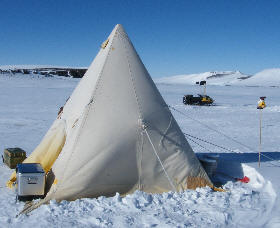
Our beloved poo tent
The squatting garden gnome (right) signifies it's "occupied."ANSMET
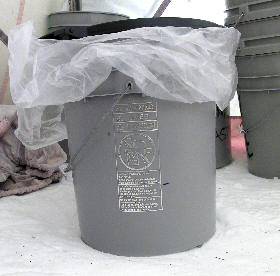
The human waste bucket
ANSMET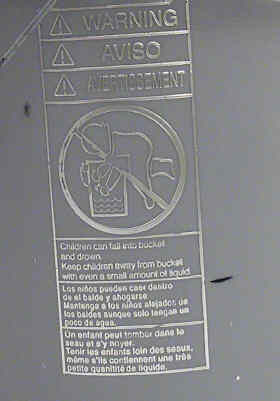
Warning! Do not to let small children fall in the bucket. We don't.
ANSMETThat isn't Pooh Bear's Tent
January 1, 2009
New Year's day is another tent day with high winds keeping us inside. We have prepared for such days, but would much rather be out hunting for those elusive meteorites!
Our first re-supply flight is scheduled for tomorrow (the Twin Otter appears with goodies required to keep us going). We feel a little like the "Cargo Cult " people of the Pacific about these flights and greet them with much excitement. Like the Cargo Cult people we will enthusiastically help unload our bounty and offer our women and other gifts in return. But being the Twin Otter, its pilots will sternly remind us that they only carry-off what is on their list, which includes spent fuel containers, trash and buckets full of human waste (but no women). They will be back in several weeks for another re-supply flight.
At this point you may say "Wait a second, back up that carry-off list again, and what is this about human waste buckets?"
Well, I have been chosen for the glamorous job of answering the most frequently asked question by primary schoolers during ANSMET presentations at their schools. (Astronauts get the same question.) That question is, of course, what do you do when nature calls in this harsh environment. In the past it was au naturale, using your snowmobile as a wind break. But now the National Science Foundation has mandated that all field parties return their human waste (a.k.a. poop) to be processed properly. This means that field parties like ours no longer have the pleasure of baring our all to the sub-zero temperatures and high winds, but instead now have a toilet, of sorts.
Our toilet is a grand construction consisting of a plastic toilet seat and cover, mounted on a 5 gallon bucket. (We have noticed that the bucket has a safety warning picture of a small child falling head first into to it and drowning -- so we have vowed to watch all small children carefully around these buckets.) This elegant toilet arrangement sits safely out of the howling winds in an old, beat-up Scott tent, which is fondly referred to as the "Poo Tent" (not to be confused with what Winnie takes with him camping). This tent is, of course, not heated and is frequently subzero inside. This means that the toilet seat can provide a real thrill (or shock) when encountered with bare skin. When the bucket is full, the lucky last user gets the honor of changing buckets (making sure no small children are injured). The used bucket gets a top, is very, very well sealed, and waits for its ride to McMurdo for processing.
It should be pointed out that we can still relieve themselves appropriately in the old fashion way outside in the brisk breeze instead of using the bucket.
In an effort to make this tent more homey, I picked up some plastic foliage in McMurdo (at Skua central, where unwanted but still usable items are placed for someone else to take and enjoy) to decorate the tent and placed a magazine next to the bucket for the reading enjoyment of those that like to linger on the toilet. So far it appears no one has opened the magazine -- I wonder why?
100 years ago this date: Shackleton and his crew continue to sledge uphill through soft snow. Their heads hurt (due to dehydration?) and are hungry because of short rations. Even so, they make 11 1/2 miles on the day and are 198 miles from the Pole.
-- Joe, former NASA program manager.
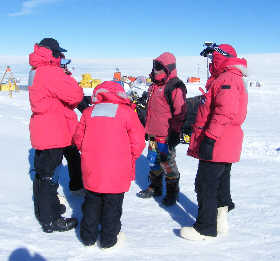
The morning gathering
...where important information is transmitted, but sometimes not received.ANSMET
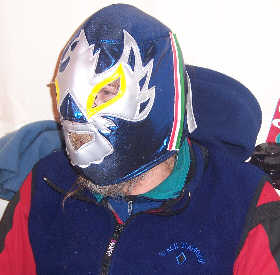
John with his 'game face' on
ANSMETCommunication, an important component of team work
January 2, 2009
Before I start the post, a message from Jani:
We have been getting feed-back from some people tracking our work on the web. We appreciate these comments and thank you for taking the time to let us know what you think. In particular, thanks for the holiday best wishes from Cammie, Ralph, Franck, Ingrid and Joe, Karen, Troy, and some unknown well wishers (try to sign your texts!) Also, huge thanks for the goodies from Lucy McFadden, Mike Kelley, Tani and Lee, Amber and Mel, Andy and Jen, Barbara Cohen, and Debbie and Brian -- we love you!
Now back to the topic of the day.
Anytime you have a team of people working toward a common goal, it is critical that the members of the team communicate clearly. Without this, the team cannot function at a high degree of efficiency. ANSMET is no exception.
When we start a day's work, we first get our ski-doos ready, loading them up with whatever gear we think we will need to do the day's work and food and drink to sustain us. After that, we all gather around John. He describes in general terms what we will be doing so that we all understand the general structure of the day. Like ants in a nest, we have gotten our marching orders and it is time to go out and get to work.
Sometimes, however, the message does not get successfully transmitted to everyone. Earlier in the season, the marching orders I heard in the morning gathering were that we would first collect two meteorites that were flagged near camp, and then go out and continue sweeping the ice where we had been working the day before.
After collecting the second meteorite, and while the rest of us were putting away the collecting gear, putting on gloves, etc., John started up his snowmobile and drove off. This prompted the following brief conversation:
Deon: "Where is John going?"
me: "Sweeping."
Deon: "What should we do?"
me: "Follow."
Deon is relatively new at ANSMET work, and he hadn't yet experienced this particular form of communication; John disappearing in the distance. It is an unmistakable sign that it is time to get our butts in gear.
ANSMET also has a number of non-verbal communication avenues we use when we are too far apart for conversation. John driving away on his ski-doo is one of them, but the most common is rhythmically crossing and uncrossing the hands over the head. This signifies "come to me" and is most commonly used when someone finds a meteorite and needs the team to gather to collect it. This sign should not be confused with hands wildly flailing in all directions, which typically means "my hands are freezing; I cannot get them warm," although sometimes it can just be a sign of dancing.
As the reader can see, ANSMET has developed a system of verbal and non-verbal communications over the years that occasionally results in transmission of useful information.
One comment we got recently was that some readers would like to see more pictures of people. Here then is a picture of John with his "game face" on.
100 years ago this date: Shackleton and lads continue to face hard work sledging up hill through soft snow, all the while suffering from hunger and headaches. Nevertheless, they make ten and a quarter miles. Shackleton is starting to consider the need to turn back short of the goal for the sake of safe return.
Cheers,
LYAN
duck
A good day at the office
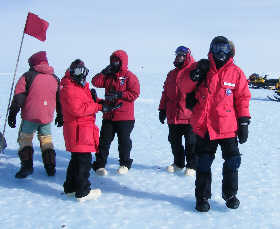
End of a long day
Exhibiting weariness near the end of a long day, the meteorite hunters have another one in the bag.ANSMET
January 3, 2009
We finally caught a break. The weather cooperated with us. It was -19 C (-2 F) and the winds were quite moderate when we got up. We were able to go out for a full day's work for a change, and we put it to good use.
After collecting a few meteorites that we had flagged on previous days, we went back out to the ice field southeast of camp where we had been working up until the weather turned sour several days ago. Our searching turned up 55 meteorites for the day, most of them late in the day, which delayed our return to camp. It was our best day yet. So far for the expedition we have collected 182 meteorites. One of the meteorites we collected today appears to us to be unusual, and we cannot wait to find out what it is. That will take some time; the meteorites will not even arrive at the laboratory in Houston until sometime in March.
We spent nearly 10 hours out on the ice, and we are exhausted. So please excuse the brevity of this post.
100 years ago this date: Shackleton's team had what they describe as a warm day; it was -8 F at noon. They continue sledging uphill and made 11 miles towards their goal. Shackleton is considering setting up one more food depot and then making a dash for the Pole hauling as light a load as possible.
Cheers,
LYAN
duck
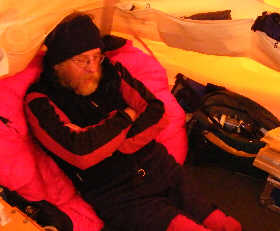
John demonstrates a proper Antarctic 'idle.'
ANSMET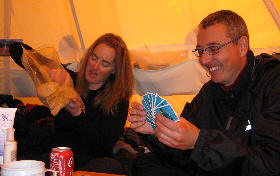
More idling
ANSMETThe Antarctic deep field is not for the impatient
January 4, 2009
Well, here we are again, stuck in our tents. During the night Mother Nature decided to bring on the winds again. When I woke up, it was not too cold, only -19 C (-2 F), so that was a break for us. But I could hear the tent sides flapping in the wind and the driven snow hissing against the tent. I was nice and warm in my sleeping bag, and wanted to stay that way. Even the thought of a morning cup of coffee did not tempt me out of the sack.
The wind is not so strong today that we could not get out and work, but our efficiency would be way down, and we would likely miss a lot of meteorites that we would easily see on a calm day. So, it is rather pointless to try to work on a day like today. We would only have to go out and redo it.
This brings up the subject of "How do we spend the long tent-bound hours?"
Well first off, if you are the type of person who does not "idle" well, don't even think of volunteering for ANSMET. If you get impatient and antsy when things do not run as smoothly as you think they should, Antarctica is not for you. If you hate sitting through rain delays at a baseball game, Antarctica is not for you. Ditto if you hate waiting for the pitcher to decide which pitch to throw. On the other hand, if you can sit in stalled commuter traffic with a fatalistic attitude and the comforting knowledge that eventually you will get home, maybe you should consider working in Antarctica.
It is not uncommon to have several tent days in a row, and there is absolutely nothing you can do about it. You may as well try to make the best of it. If you ever intend to do deep field research in Antarctica, here are some ideas for ways to idle away the bad weather hours. In no particular order:
1. Reading is probably the most common tent day activity. It is especially a good idea to bring books you always intended to read but somehow never got around to. This is my 25th day in the field and I am well into my fifth book. Get the picture? Bring lots of reading material.
2. Thought puzzles are good for those who enjoy them. I have two books of cryptograms, one of which is half done. John does crossword puzzles. No one else on the team seems to be interested in thought puzzles though.
3. Games are fine for when people gather in one tent. I haven't played any yet this expedition, but I caught Amy, Jani and Deon in a cutthroat game of Rook when I went to their tent to see what they were up to.
4. Eating! It seems when you are forced to stay in your tent, it is almost unavoidable that you will begin to snack on whatever is handy. Tent days are bad for those trying to manage their weight.
5. Keep a journal. My first trip down in 1997 I started keeping a log of daily events, especially the unusual things, that happened. I have kept it up with every succeeding trip. It is a nice record to remind me of the good times (and not so good) I have had in Antarctica. Amy and Jani are also keeping journals. Jani's includes a record of the weather data she collects with a portable weather station.
6. Watch movies. Deon brought a collection of DVDs with him. An afternoon matinee is a good way to pass a couple of hours. After enough tent days, even bad movies will seem like Academy Awards quality films. I do not recommend slasher films if you are at all concerned about your tent mates mental state after suffering through yet another tent day.
7. Work, work, work. Some of us have jobs associated with the field work that extends beyond the daily search. John manages the global positioning and field data we acquire for each meteorite and he plots their locations on a map of the ice fields. Amy takes pictures of all the meteorites, and sorts through these in the off-hours to keep a master folder of the best images. I manage the weblog, and make sure it gets uploaded every day. Scientists can never leave their pet projects behind, and some of us have been doing "homework" while here. Joe for example, reads nerdy science articles. Deon in particular wants his doctoral committee to know that he avidly works on research data on tent days. No, really.
8. And last, the ever popular crawl back in the sleeping bag and take a nap. Wake me for lunch. And Supper. According to rumor, this is Joe's favorite pastime.
Finally, Joe would like to thank Keiko and the 04-05 ANSMET team for the care package they sent. And Stan, there are still many people in high office at JSC that owe Joe favors.
100 years ago this date: Shackleton and his stalwart team fear they can continue only three more days. They are weakening from hunger and hard work, have cut faces, constant trouble with frostbite, and their boots and clothes are wearing out. The day they faced brought strong katabatic winds and a temperature of -12 F, yet they were able to make 14 miles toward their goal.
Cheers,
LYAN
duck
Support our core enterprises
Your support powers our mission to explore worlds, find life, and defend Earth. You make all the difference when you make a gift. Give today!
Donate

 Explore Worlds
Explore Worlds Find Life
Find Life Defend Earth
Defend Earth

